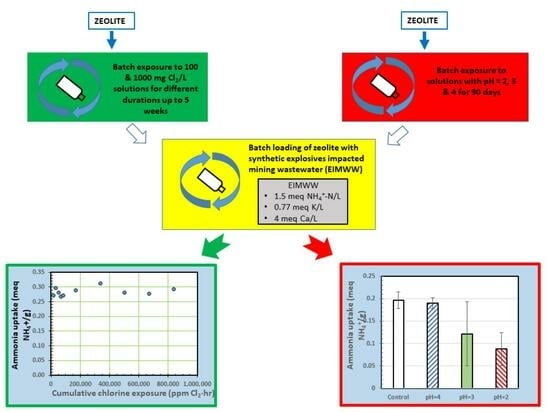Impact of Long-Term Exposure to High Chlorine and to Low pH Solutions during Chlorine Regeneration of Ammonia-Loaded Zeolite
Abstract
:1. Introduction
2. Materials and Methods
2.1. Materials
2.2. IE Material Durability Tests with Chlorine Exposure
2.3. IE Material Durability Tests with pH Exposure
2.4. Analytical Methods
2.5. Particle/Material Characterization Methods
3. Results
3.1. Impacts of Exposure of Zeolite Particles to High Concentration Chlorine Solutions
3.1.1. Particle Size Distribution
3.1.2. SEM Analysis
3.1.3. BET Surface Area
3.1.4. FTIR Spectra
3.1.5. Ion Uptake Tests
3.2. Impact of Exposure of Zeolite Particles to Long-Term Low pH Exposure
3.2.1. Particle Size Distribution
3.2.2. SEM Analysis
3.2.3. BET Surface Area
3.2.4. Thermogravimetric Analysis (TGA)
3.2.5. PXRD Analysis
3.2.6. TAN Uptake
4. Discussion
5. Conclusions
Author Contributions
Funding
Data Availability Statement
Acknowledgments
Conflicts of Interest
References
- Hedström, A. Ion exchange of ammonium in zeolites: A literature review. J. Environ. Eng. 2001, 127, 673–681. [Google Scholar] [CrossRef]
- Huang, J.; Rathnayake Kankanamge, N.; Chow, C.; Welsh, D.T.; Li, T.; Teasdale, P.R. Removing ammonium from water and wastewater using cost-effective adsorbents: A review. J. Environ. Sci. 2018, 2018, 174–197. [Google Scholar] [CrossRef] [PubMed]
- Koon, J.H.; Kaufmann, W.J. Ammonia removal from municipal wastewater by ion exchange. J. Water Pollut. Control Fed. 1975, 47, 448–465. [Google Scholar]
- Liberti, L.; Limoni, N.; Lopez, A.; Passino, R.; Boari, G. The 10 m3h-1 RIM-NUT demonstration plant at West Bari for removing and recovering N and P from wastewater. Water Res. 1986, 20, 735–739. [Google Scholar] [CrossRef]
- Lubensky, J.; Ellersdofer, M.; Stocker, K. Ammonium recovery from model solutions and sludge liquor with a combined ion exchange and air stripping process. J. Water Proc. Eng. 2019, 32, 100909. [Google Scholar] [CrossRef]
- Huang, H.; Yang, L.; Xue, Q.; Liu, J.; Hou, L.; Ding, L. Removal of ammonium from swine wastewater by zeolite combined with chlorination for regeneration. J. Environ. Manag. 2015, 160, 333–341. [Google Scholar] [CrossRef] [PubMed]
- Schoemann, J.J. Evaluation of a South African clinoptilolite for ammonia nitrogen removal from an underground mine water. Water SA 1986, 12, 73–82. [Google Scholar]
- Chartrand, Z.G.; Narbaitz, R.M.; Sartaj, M.; Downey, J. Ammonia-Ca-K competitive ion-exchange on zeolites in mining wastewater treatment: Batch regeneration and column performance. J. Sustain. Min. 2020, 19, 59–71. [Google Scholar] [CrossRef]
- Svetich, R. Long-term use of clinoptilolite in the treatment of sewage at Tahoe-Truckee Sanitation Agency, Truckee, California. In Proceedings of the 4th International Conference on the Occurrence, Properties, and Utilization of Natural Zeolites, Boise, ID, USA, 20–28 June 1993. [Google Scholar]
- Zhang, W.; Zhou, Z.; An, Y.; Du, S.; Ruan, D.; Zhao, C.; Ren, N.; Tian, X. Optimization for zeolite regeneration and nitrogen removal performance of a hypochlorite-chloride regenerant. Chemosphere 2017, 178, 565–572. [Google Scholar] [CrossRef] [PubMed]
- Zhang, T.; Narbaitz, R.M.; Sartaj, M.; Downey, J. Chlorine vs. sodium chloride regeneration of zeolite column for ammonium removal from an explosives impacted mining wastewater. Water 2022, 14, 3094. [Google Scholar] [CrossRef]
- ResinTech Inc. Resintech SIR-600. 2019. Available online: https://www.resintech.com/rks_images/shopcart/pdf_specs_90253.pdf (accessed on 25 October 2019).
- Kurama, H.; Zimmer, A.; Reschetilowski, W. Chemical modification effect on the sorption capacities of natural clinoptilolite. Chem. Eng. Technol. 2002, 25, 301–305. [Google Scholar] [CrossRef]
- Cakiicioglu-Ozkan, F.; Ulku, S. The effect of HCl treatment on water vapor adsorption characteristics of clinoptilolite rich natural zeolite. Microporous Mesoporous Mater. 2005, 77, 47–53. [Google Scholar] [CrossRef]
- ResinTech Inc. Resintech SIR-600. 2023. Available online: https://www.resintech.com/wp-content/uploads/2021/06/SDS-SIR-600.pdf (accessed on 20 February 2023).
- Chartrand, Z. The Selective Ion-Exchange Removal of Ammonia from Mining Wastewater. Master’s Thesis, Department of Civil Engineering, University of Ottawa, Ottawa, ON, Canada, 2018. [Google Scholar] [CrossRef]
- Zhang, T. Ammonia Removal from Mining Wastewater by Ion-Exchange Regenerated by Chlorine Solutions. Master’s Thesis, Department of Civil Engineering, University of Ottawa, Ottawa, ON, Canada, 2022. [Google Scholar] [CrossRef]
- APHA. Standard Methods for the Examination of Water and Wastewater, 18th ed.; American Public Health Association: Washington, DC, USA, 1992; Available online: https://www.scirp.org/(S(351jmbntvnsjt1aadkposzje))/reference/ReferencesPapers.aspx?ReferenceID=1818549 (accessed on 30 August 2022).
- APHA. Standard Methods for the Examination of Water and Wastewater, 23rd ed.; American Public Health Association: Washington, DC, USA, 2017; Available online: https://scirp.org/reference/referencespapers.aspx?referenceid=2329795 (accessed on 30 August 2022).
- ASTM D6913/D6913M-17; Standard Test Methods for Particle-Size Distribution (Gradation) of Soils Using Sieve Analysis. ASTM International: West Conshohocken, PA, USA. 2017. Available online: www.astm.org (accessed on 10 May 2021).
- Ghasemian, N.; Falamaki, C. Zn2+, Fe2+, Cu2+, Mn2+, H+ Ion-exchanged and raw clinoptilolite zeolite catalytic performance in the Propane-SCR-NOx process: A comparative study. Int. J. Chem. React. Eng. 2017, 16, 20160192. [Google Scholar] [CrossRef]
- Chen, H.Y.; Lin, Y.; Chen, B.; Yoshiyuki, I.; Liou, S.Y.; Huang, R. A further investigation of NH4+ removal mechanisms by using natural and synthetic zeolites in different concentrations and temperatures. Minerals 2018, 8, 499. [Google Scholar] [CrossRef]
- Thommes, M.; Kaneko, K.; Neimark, A.V.; Olivier, J.P.; Rodriguez-Reinoso, F.; Rouquerol, J.; Sing, K.S.W. Physisorption of gases, with special reference to the evaluation of surface area and pore size distribution (IUPAC Technical Report). Pure Appl. Chem. 2015, 87, 1051–1069. [Google Scholar] [CrossRef]
- Korkuna, O.; Leboda, R.; Skubiszewska-Ziemba, J.; Vrublevska, T.; Gunko, V.M.; Ryczkowski, J. Structural and physicochemical properties of natural zeolites: Clinoptilolite and mordenite. Microporous Mesoporous Mater. 2006, 87, 243. [Google Scholar] [CrossRef]
- McCusker, L.B.; Baerlocher, C. Zeolite structure. In Introduction to Zeolite Science and Practice, 3rd ed.; Čejka, J., Ed.; Elsevier: Amsterdam, The Netherlands, 2007; Chapter 2; pp. 13–38. [Google Scholar] [CrossRef]
- Mintova, S.; Čejka, J. Micro/mesoporous composites. In Introduction to Zeolite Science and Practice, 3rd ed.; Čejka, J., Ed.; Elsevier: Amsterdam, The Netherlands, 2007; Chapter 9; pp. 301–326. [Google Scholar] [CrossRef]
- Lercher, J.A.; Jentys, A. Infrared and Raman spectroscopy for characterizing zeolites. In Introduction to Zeolite Science and Practice, 3rd ed.; Čejka, J., Ed.; Elsevier: Amsterdam, The Netherlands, 2007; Chapter 13; pp. 435–476. [Google Scholar] [CrossRef]
- Mozgawa, W. The influence of some heavy metals cations on the FTIR spectra of zeolites. J. Mol. Struct. 2000, 555, 299–304. [Google Scholar] [CrossRef]
- Ames, L.L. The cation sieve properties of clinoptilolite. Am. Mineralogist. 1960, 45, 689–700. [Google Scholar]
- Flohr, M.J.K. X-ray Powder Diffraction. US Geological Surveys Information Handout. 1997. Available online: https://pubs.usgs.gov/info/diffraction/html/ (accessed on 2 September 2023).
- Hernández-Beltrán, N.A.; Olguín, M.T.; Rosas-Aburto, A. Effect of acid phosphate media on the stability of clinoptilolite-rich tuff. J. Incl. Phenom. Macrocycl. Chem. 2008, 61, 93–100. [Google Scholar] [CrossRef]
- Akerele, G.O. Bench-Scale SIR-600 Ion- of Exchange Column and Cl2 Regeneration for Ammonia Removal from a Simulated Mining Wastewater. Master’s Thesis, Department Civil Engineering, University of Ottawa, Ottawa, ON, Canada, 2022. [Google Scholar] [CrossRef]
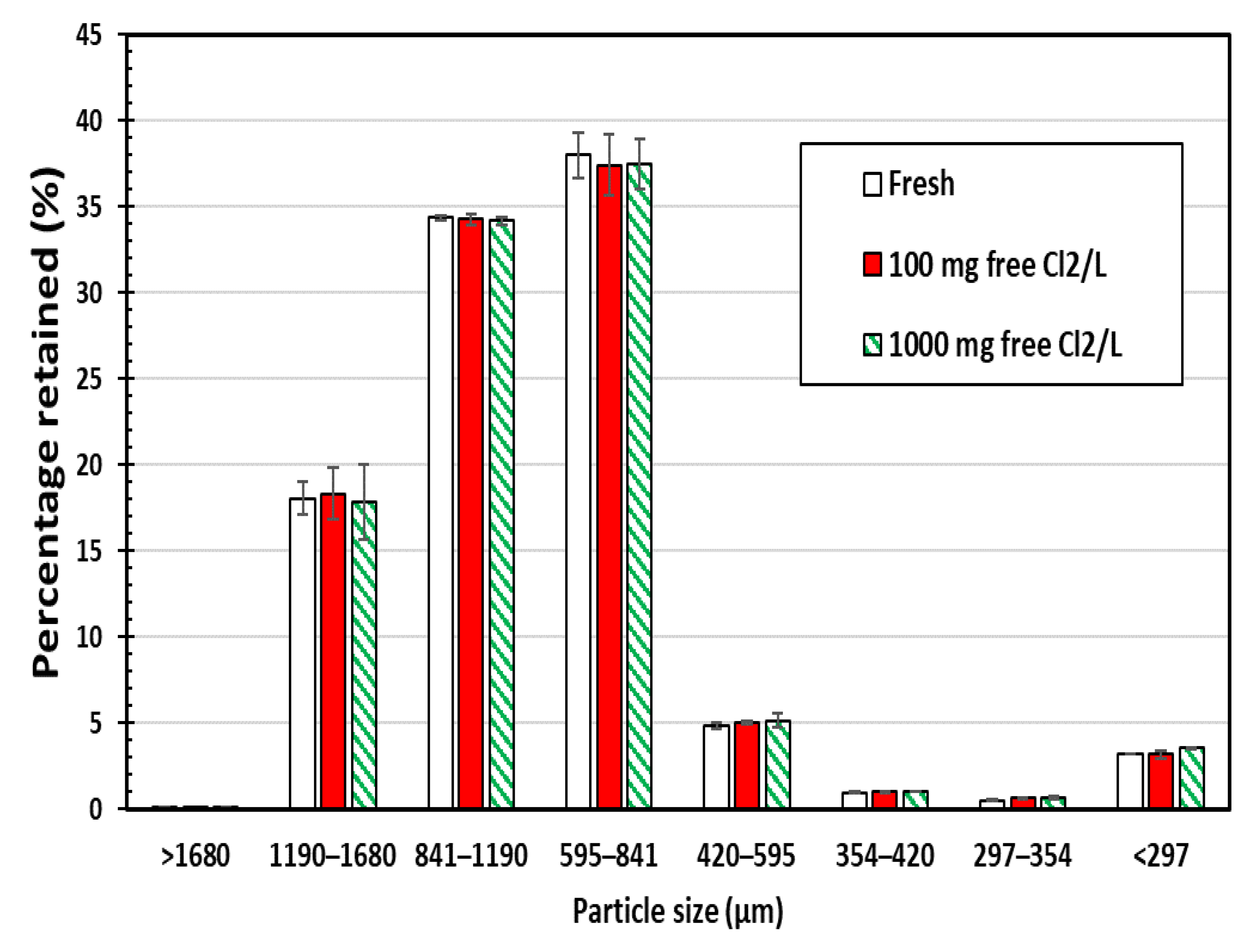
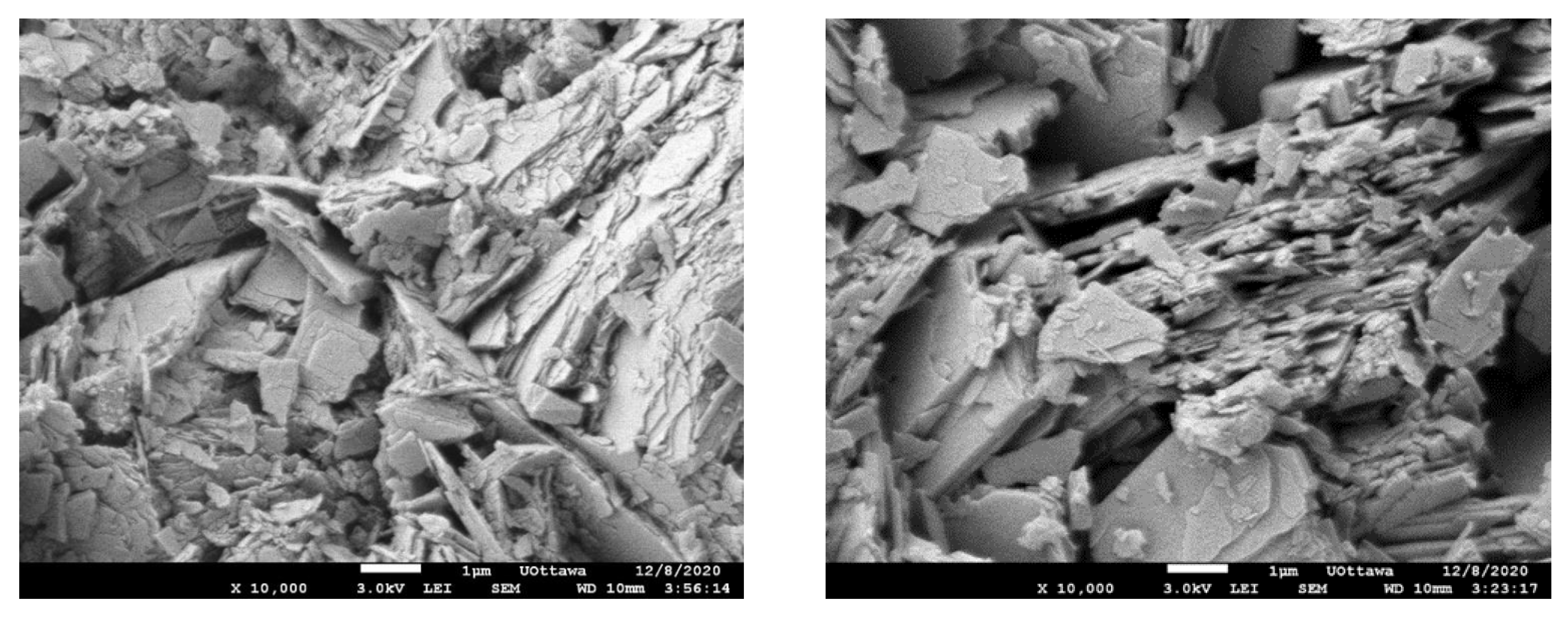

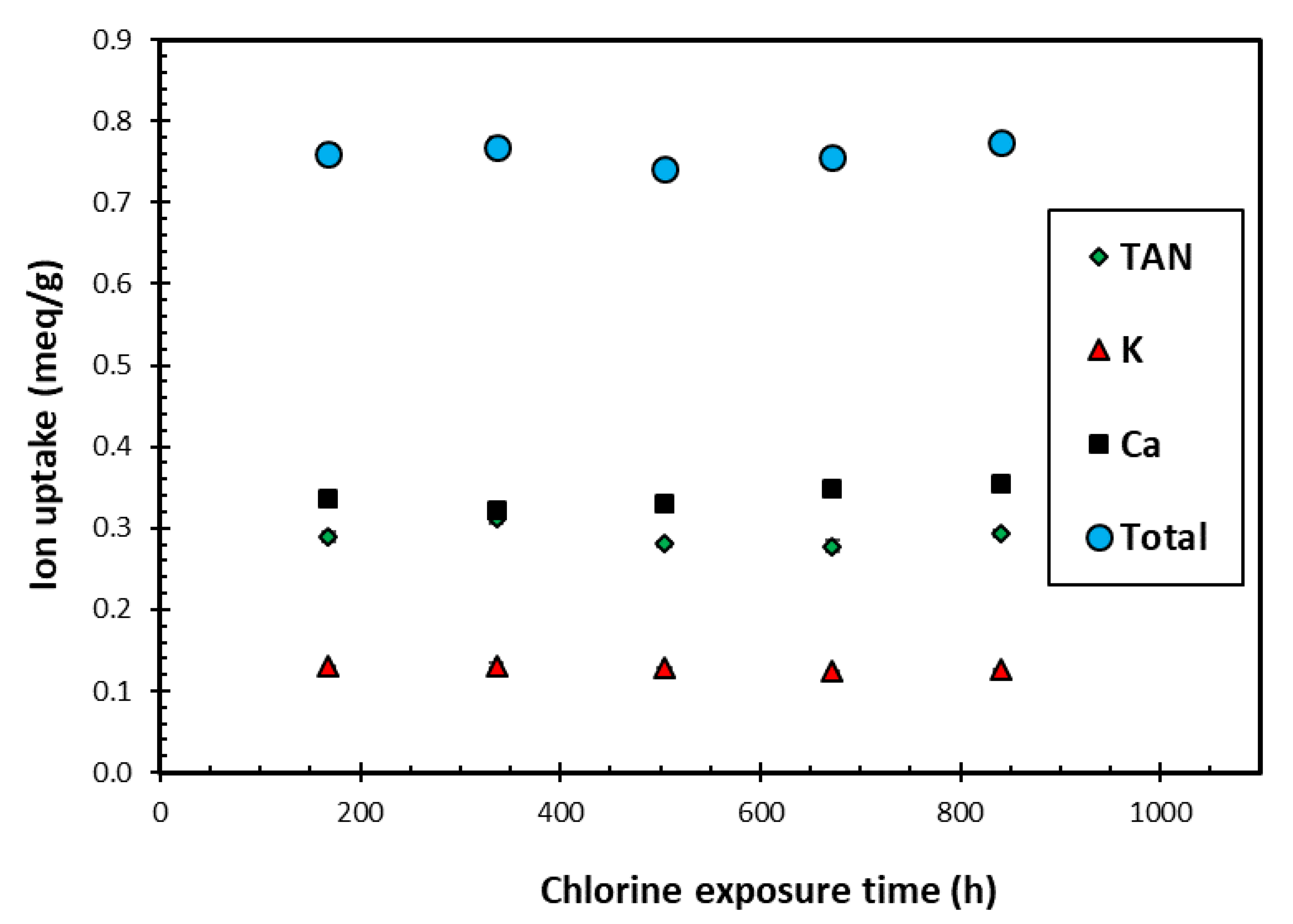
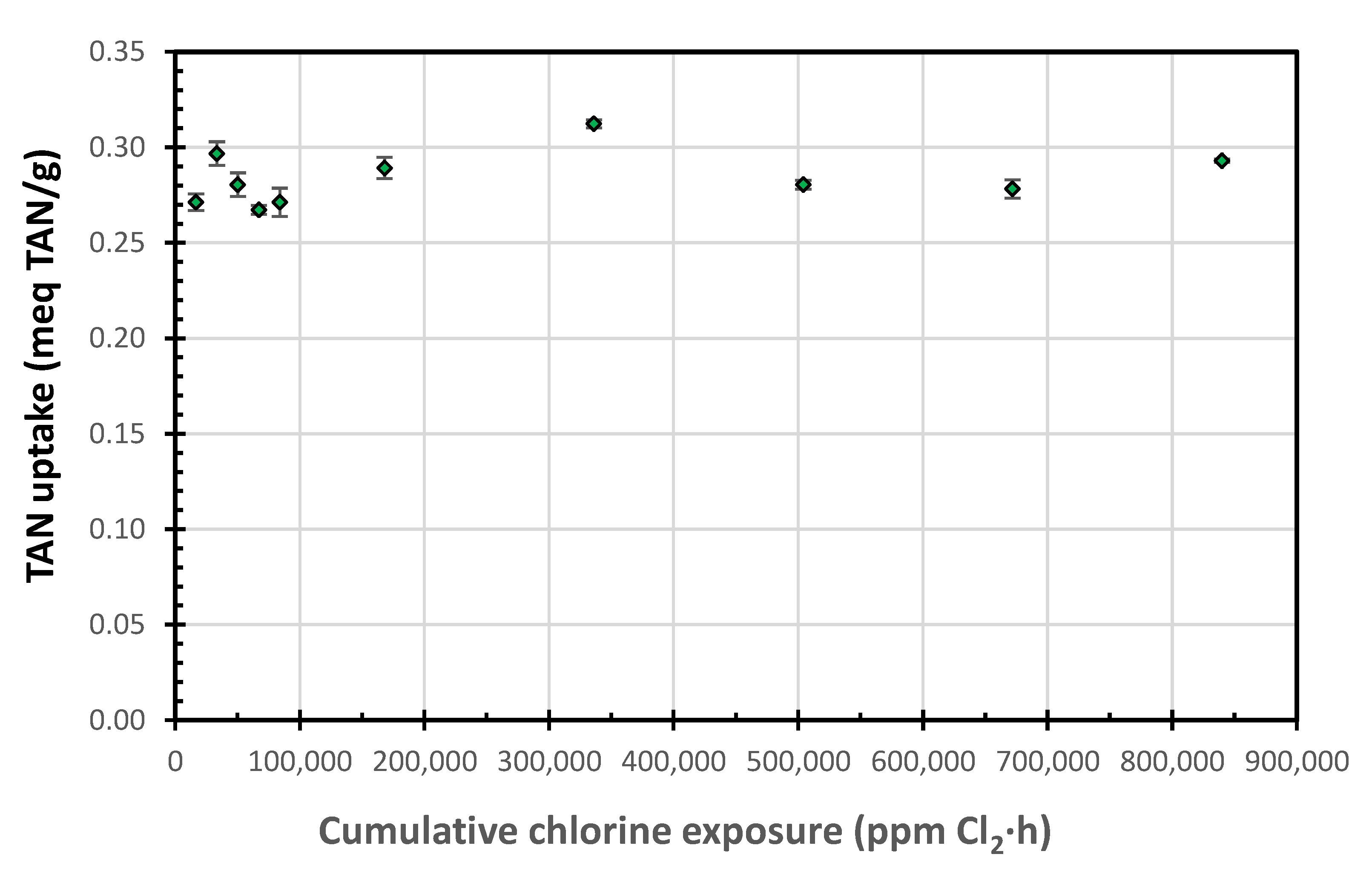
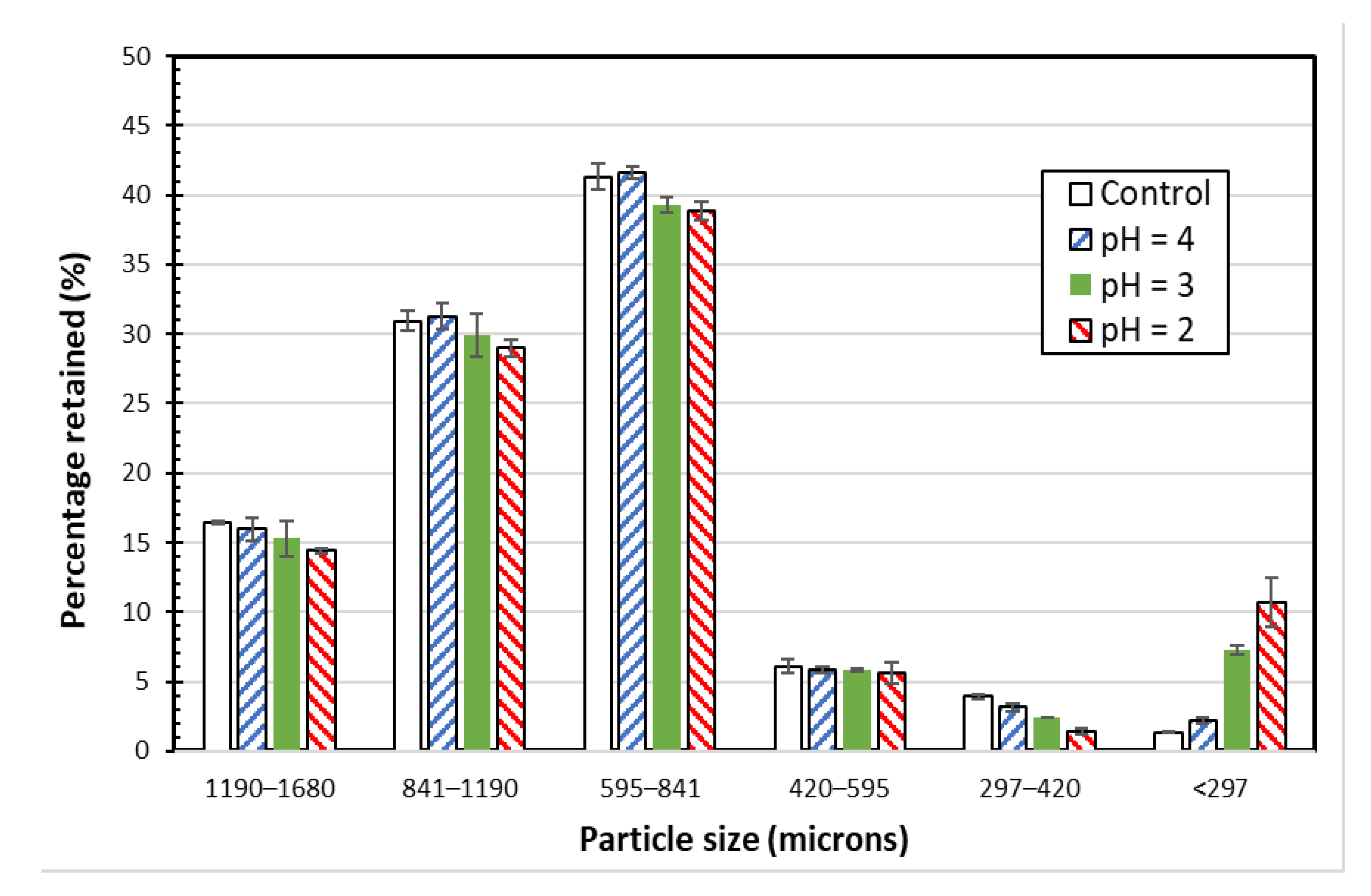
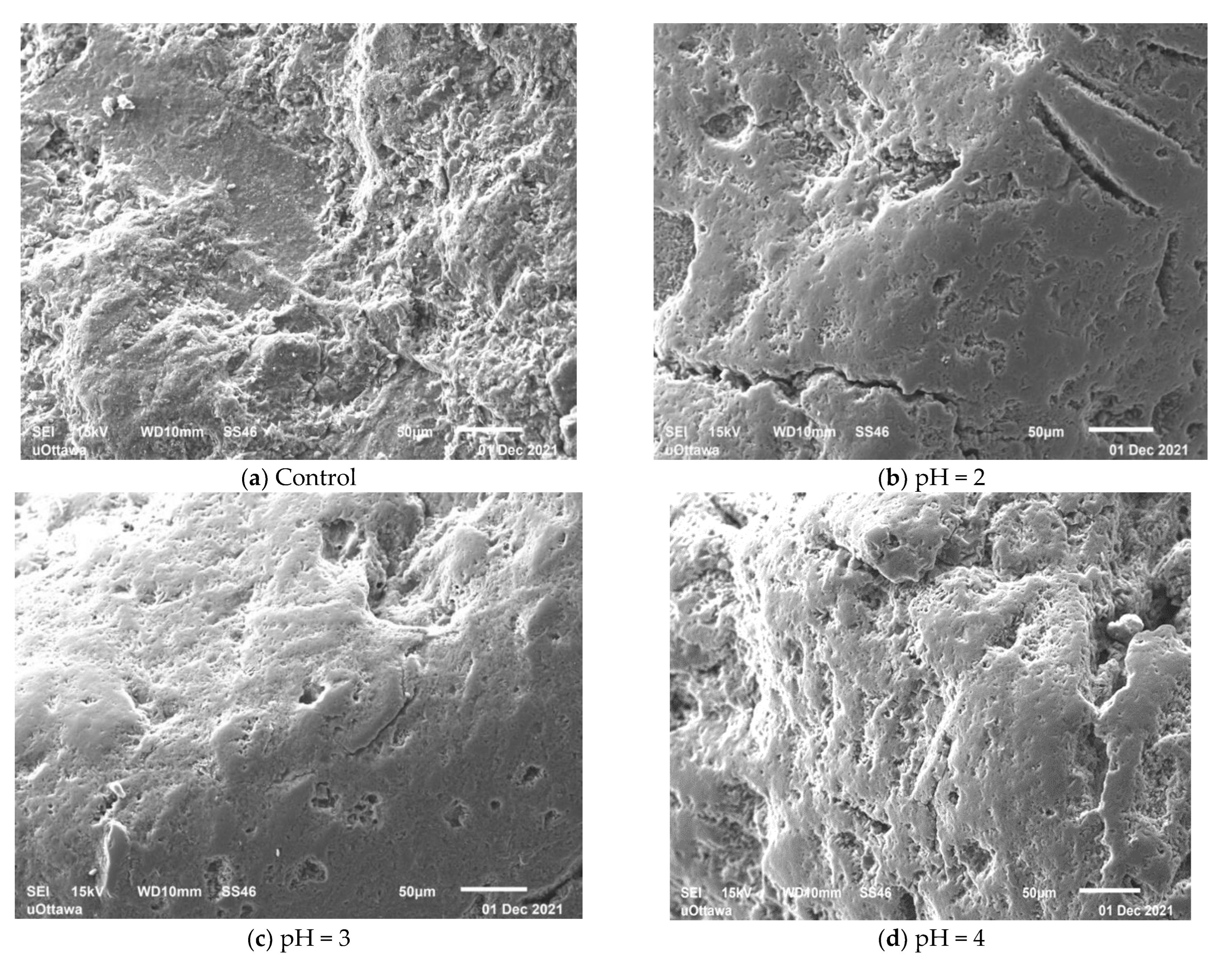
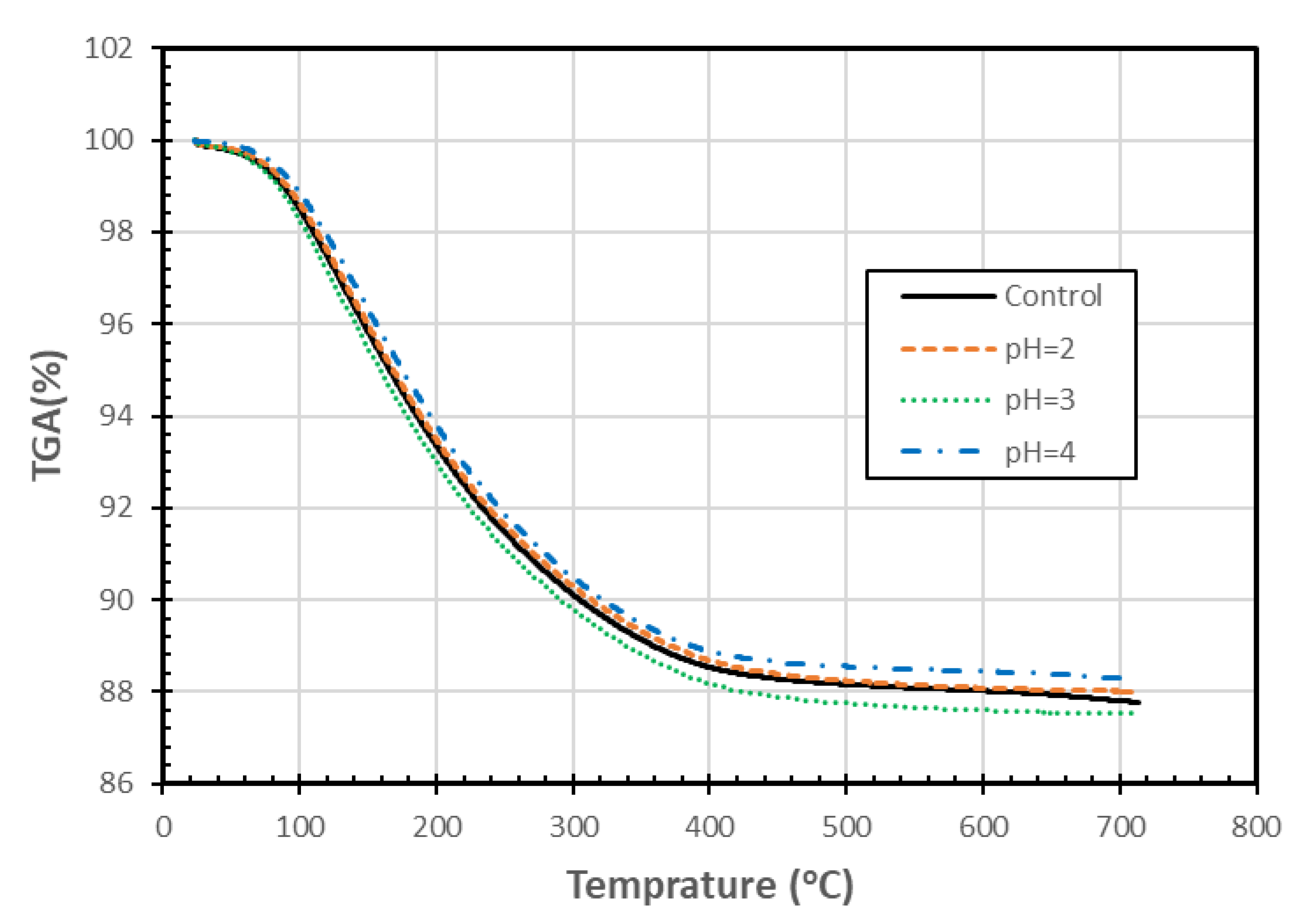
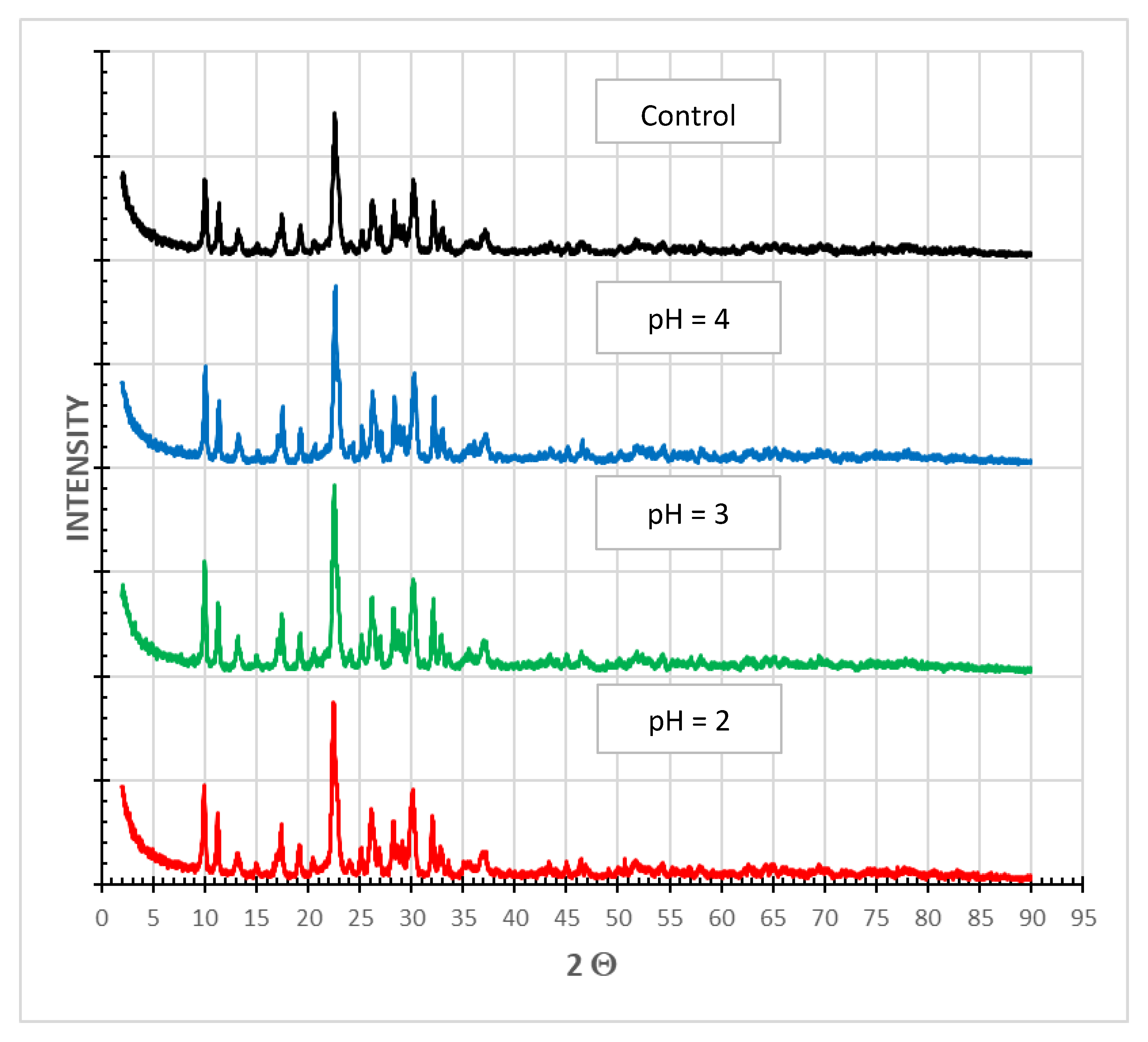
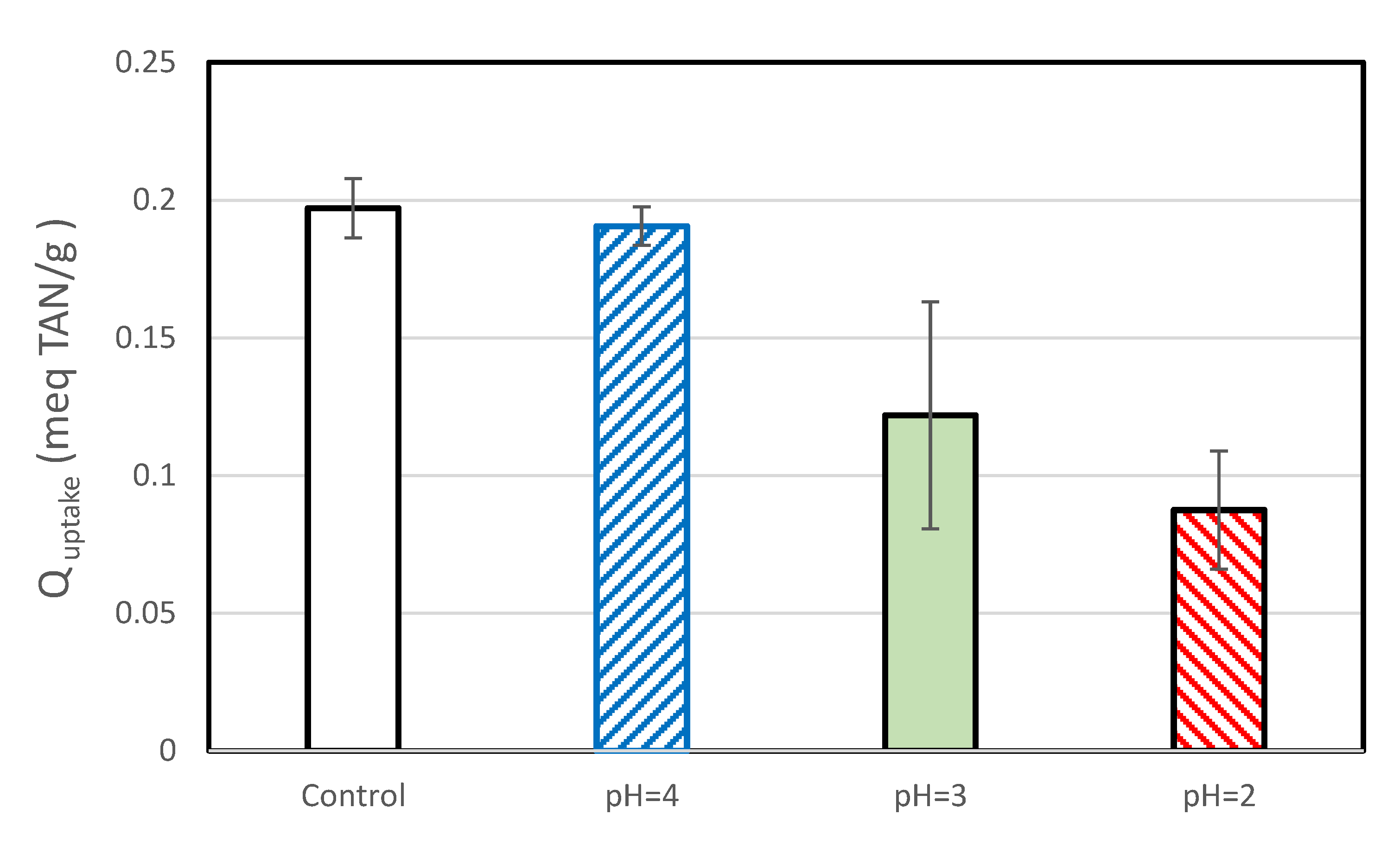
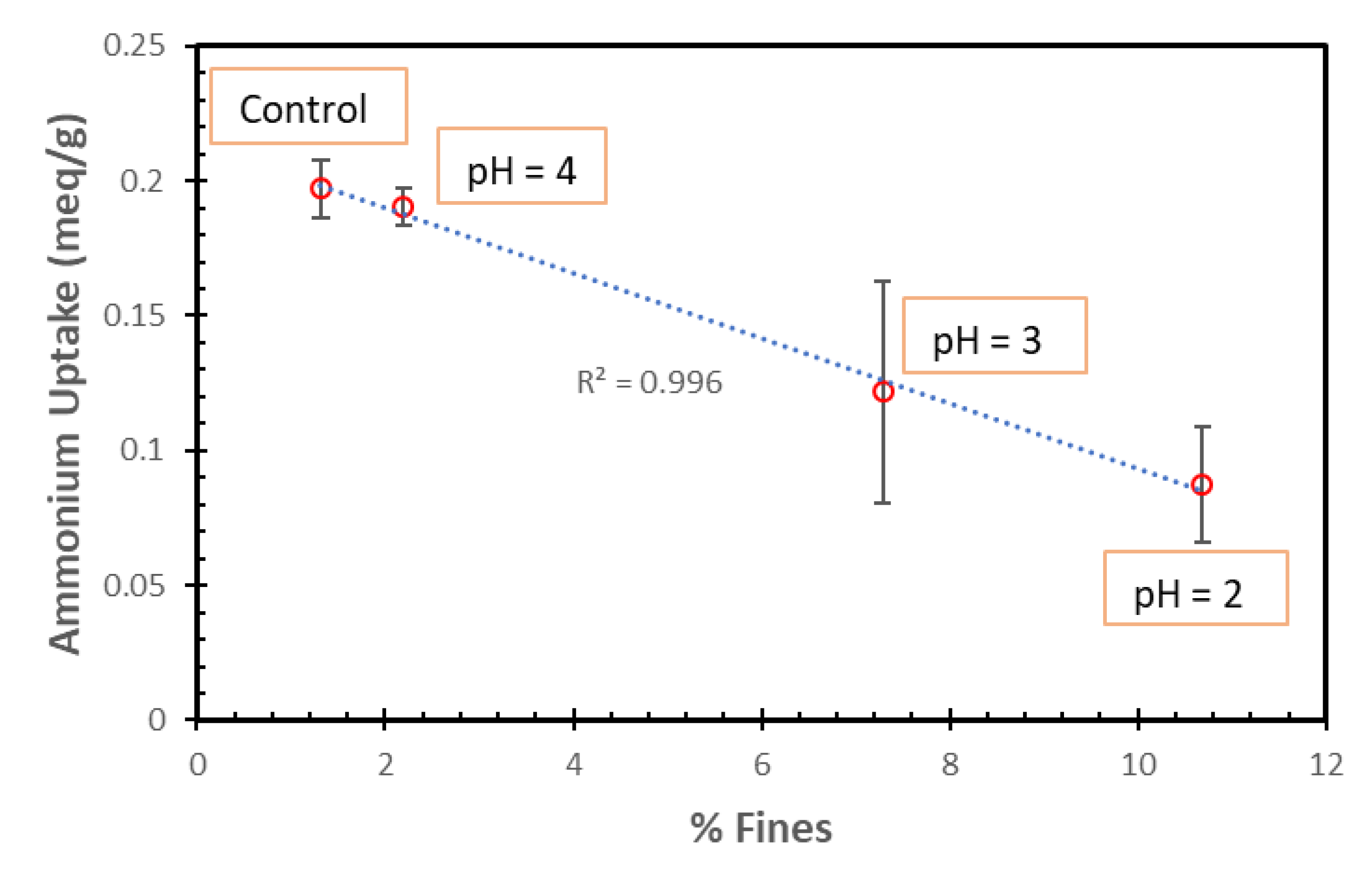
| Material Structure | Zeolite |
|---|---|
| Material type | Crystalline |
| Functional groups | Aluminosilicate |
| Physical form | Granules |
| Granule size | 425 to 1700 μm |
| Maximum fines (<300 μm) | 5% |
| Ionic form (as shipped) | Sodium/potassium |
| Total capacity | 1.4–1.6 meq/mL |
| Cumulative free chlorine capacity | ≥106 ppm h |
| pH range | 3 to 10 |
Disclaimer/Publisher’s Note: The statements, opinions and data contained in all publications are solely those of the individual author(s) and contributor(s) and not of MDPI and/or the editor(s). MDPI and/or the editor(s) disclaim responsibility for any injury to people or property resulting from any ideas, methods, instructions or products referred to in the content. |
© 2023 by the authors. Licensee MDPI, Basel, Switzerland. This article is an open access article distributed under the terms and conditions of the Creative Commons Attribution (CC BY) license (https://creativecommons.org/licenses/by/4.0/).
Share and Cite
Narbaitz, R.M.; Zhang, T.; Akerele, G.O.; Sartaj, M.; Downey, J. Impact of Long-Term Exposure to High Chlorine and to Low pH Solutions during Chlorine Regeneration of Ammonia-Loaded Zeolite. Minerals 2023, 13, 1247. https://doi.org/10.3390/min13101247
Narbaitz RM, Zhang T, Akerele GO, Sartaj M, Downey J. Impact of Long-Term Exposure to High Chlorine and to Low pH Solutions during Chlorine Regeneration of Ammonia-Loaded Zeolite. Minerals. 2023; 13(10):1247. https://doi.org/10.3390/min13101247
Chicago/Turabian StyleNarbaitz, Roberto Martin, Tianguang Zhang, Grace Oluwatomisin Akerele, Majid Sartaj, and Jason Downey. 2023. "Impact of Long-Term Exposure to High Chlorine and to Low pH Solutions during Chlorine Regeneration of Ammonia-Loaded Zeolite" Minerals 13, no. 10: 1247. https://doi.org/10.3390/min13101247
APA StyleNarbaitz, R. M., Zhang, T., Akerele, G. O., Sartaj, M., & Downey, J. (2023). Impact of Long-Term Exposure to High Chlorine and to Low pH Solutions during Chlorine Regeneration of Ammonia-Loaded Zeolite. Minerals, 13(10), 1247. https://doi.org/10.3390/min13101247







